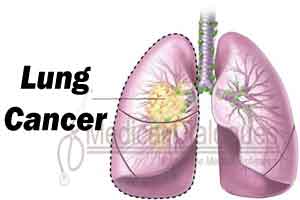- Home
- Editorial
- News
- Practice Guidelines
- Anesthesiology Guidelines
- Cancer Guidelines
- Cardiac Sciences Guidelines
- Critical Care Guidelines
- Dentistry Guidelines
- Dermatology Guidelines
- Diabetes and Endo Guidelines
- Diagnostics Guidelines
- ENT Guidelines
- Featured Practice Guidelines
- Gastroenterology Guidelines
- Geriatrics Guidelines
- Medicine Guidelines
- Nephrology Guidelines
- Neurosciences Guidelines
- Obs and Gynae Guidelines
- Ophthalmology Guidelines
- Orthopaedics Guidelines
- Paediatrics Guidelines
- Psychiatry Guidelines
- Pulmonology Guidelines
- Radiology Guidelines
- Surgery Guidelines
- Urology Guidelines
Osimertinib in lung cancer: added benefit not proven

Osimertinib has been approved since February 2016 for the treatment of adult patients with locally advanced or metastatic epidermal growth factor receptor (EGFR) T790M mutation positive non small cell lung cancer (NSCLC). The German Institute for Quality and Efficiency in Health Care (IQWiG) now examined in an early benefit assessment whether the drug offers an added benefit for these patients in comparison with the appropriate comparator therapy.
Depending on the patients' pretreatment and mutation status, several research questions and corresponding appropriate comparator therapies were to be distinguished. An added benefit was not proven for any of the research questions because the drug manufacturer presented no study data suitable and informative for an early benefit assessment. The effects in its historical comparisons were too small to derive conclusions on an added benefit.
Drug binds only to mutant enzyme
Osimertinib belongs to the class of EGFR tyrosine kinase inhibitors. The drug does not bind to the tyrosine kinase wild type, but only to the mutant form, which can develop in the carcinoma during NSCLC treatment and may make treatment with other EGFR tyrosine kinase inhibitors ineffective.
The appropriate comparator therapy for patients with T790M mutation who have already been pretreated with another inhibitor was either chemotherapy or if this was not an option best supportive care (BSC), i.e. best possible supportive therapy, optimized for the individual patient, for alleviation of symptoms such as pain, and for improvement in the quality of life. The manufacturer conducted so-called historical comparisons for this group to prove an added benefit.
All other patients were treated with other tyrosine kinase inhibitors, chemotherapy, or also BSC, depending on their treatment and mutation status and their health status. The manufacturer did not submit any comparative data for these groups.
Historical comparisons: no dramatic effects
The first two of the three historical comparisons were based on two one-arm prospective studies on osimertinib on one side, and on seven retrospective analyses and two arms from different randomized controlled trials on chemo-therapies on the other side. In the third historical comparison, the manufacturer used the control arm of a study in which patients had received placebo and BSC for cases where chemotherapy was not an option. Only one of the historical comparisons actually addressed the research question of the benefit assessment. However, no effects that were large enough to derive an advantage or disadvantage of osimertinib were shown in this comparison.
The other historical comparisons were unsuitable for various reasons. In the comparative studies in particular, the T790M mutation status was not considered, and the chemo-therapies were mostly not conducted in compliance with the approval. Furthermore, these comparisons hardly contained data on patient-relevant outcomes. Consequently, it was concluded also for them and hence for the entire early benefit assessment: An added benefit of osimertinib in comparison with the appropriate comparator therapies is not proven.
G-BA decides on the extent of added benefit
This dossier assessment is part of the early benefit assessment according to the Act on the Reform of the Market for Medicinal Products (AMNOG) supervised by the Federal Joint Committee (G-BA). After publication of the dossier assessment, the G-BA conducts a commenting procedure and makes a final decision on the extent of the added benefit.

Disclaimer: This site is primarily intended for healthcare professionals. Any content/information on this website does not replace the advice of medical and/or health professionals and should not be construed as medical/diagnostic advice/endorsement or prescription. Use of this site is subject to our terms of use, privacy policy, advertisement policy. © 2020 Minerva Medical Treatment Pvt Ltd